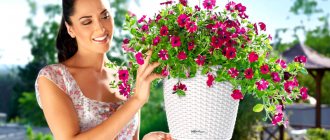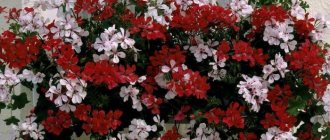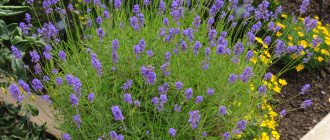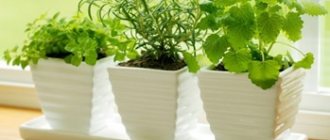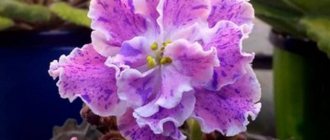Hanging plants are flowers, berries and vegetables that are intended for planting in hanging flowerpots. With their help, experienced flower growers successfully decorate the upper tiers of gazebos, fences and mansions. Even a separate class of flowering crops has appeared - ampelous flowers. This group usually includes ornamental annuals like petunias or lobelias.
However, hanging gardens have much more to offer than simple color variety. In hanging containers, semi-shrubs are especially expressive. With their help, you can create compositions in a room or on a balcony, similar to those usually found in stationary gardens.
Subshrubs and perennials in flowerpots
For example, in the gardens of the southern region, gardeners are often delighted by roses adjacent to or even entwined with thuja or juniper. A similar composition in the style of timeless English classics can be created in a flower pot. Only in it the function of turbulent dense thickets, contrasting with flowers, will be performed by ivy.
An excellent solution is white smart roses and ivy. This combination is somewhat reminiscent of mountain peaks: the snowy-delicate purity of silk petals is in perfect harmony with a lush cascade of clearly defined leaves on long flowing vines.
Such compositions, when bright double ampelous flowers dominate the dense mass of greenery, are quite impressive.
There are other options for combinations with curly hair - more complex or unusual:
- large-flowered bush pelargoniums, framed by thickets of white or blue morning glory, lined with a long edge of awl-shaped phlox;
- tall cyclamens in company with hanging tomatoes hanging from the edges of the flowerpot;
- even ordinary strawberries will look original, and in an ensemble with thyme and oregano they will fill the garden with aroma.
All options are expressive in their own way. At the same time, each of them creates a feeling of freshness and comfort.
Dichondra ampelous: photos of “waterfalls”, “backgrounds”, “foundations”
Ampelous dichondra can be classified as one of those plant species that have not yet been fully appreciated. You can see it more often in those areas that were designed by professional designers. Ampelous plants are not only stems strewn with flowers. In particular, dichondra has decorative leaves. The peculiarity of the plant lies not only in their color, but also in the abundant fluffy mass that the flower, under optimal conditions, can gain in just two to three weeks.
The most common types are dichondra “silver waterfall” and “emerald waterfall”. The densely cascading, fairly straight stems are truly associated with a waterfall. The words "silver" and "emerald" indicate the color of the leaves.
The flower is extremely unpretentious, does not require frequent and abundant watering, and can withstand high temperatures. Loves external spraying with warm water. The emerald species feels comfortable in the shade.
Quite often, these hanging flowers for pots (photos on the Internet clearly demonstrate this) are used when decorating areas as a background, shading and emphasizing the brightness of other flowering plants. Several dichondras, arranged in a certain order, can form a tent, hedge and other three-dimensional figures.
What plants can grow in hanging ensembles
Compositions of hanging flowers for pots allow you to solve two problems:
- create bright plant cascades;
- decorate balconies, terraces, verandas throughout the summer - from April to November.
Ampelous plants for pots have a special habit. The following species can be successfully grown in hanging containers:
- creeping - in which rooting rosettes - stolons - are formed on the shoots;
- curly - those that cling to vertical surfaces with their antennae;
- climbing - vines entwining supports;
- cushion-shaped - forming a rounded dense dome.
Unusual hanging plants are becoming increasingly popular.
Tropical exotics are no longer rare. Vertical gardens are becoming more beautiful and functional every day. Recently, another trend has emerged - to use garden plants in complex compositions.
Hanging flower arrangements
Flowering plants with long stems are not able to support the weight of the green mass, so they hang down or require support.
The high decorative qualities of these flower crops, flowering during the summer, a variety of colors and unique flower shapes, allow landscape architects to widely use these plants to create unique garden compositions. Very often, hanging flowerpots are formed from several types of hanging plants, which replace each other according to flowering periods. Plants with green leaves of different tones are selected, as well as variegated varieties of hanging plants. When creating colorful compositions in hanging flowerpots, you should select flowering crops by color - it is very important to achieve a harmonious combination.
Pots with bright flowers will decorate any area of the garden
You can decorate open courtyard verandas, terraces, and gazebos with hanging compositions. Pots with a cascade of bright flowers are appropriate in small cozy courtyards, patios, large gardens and city parks.
By creating a picture of flowering hanging baskets, you can constantly update your garden design by swapping out compositions of climbing plants. It is quite possible to revive the most unpresentable areas of the garden with the help of a blooming oasis of bright hanging flowers. Winter gardens and insulated loggias are decorated with flowering cascades of colorful plants that thrive in warm rooms in the winter.
Attention! Ampelous plants are absolutely undemanding in care; even a novice gardener can cope with their cultivation.
New types of plants that are used in canopy gardening
We can say that vertical gardening expands horizons - both literally and figuratively. Flower shops are expanding their range and delighting customers with new types and varieties of hanging flowers. We'll introduce you to some of them.
- Pelargonium ivy - lush caps with bright pink or scarlet inflorescences, very similar to geraniums.
- Bolivian Begonia has cascading, well-leafed stems, densely dotted with red-purple or yellow-orange corollas.
- Fuchsia - cascades of gypsy earrings purple-white or purple-crimson. They remain decorative for 2–3 months.
- Verbena - numerous flowers are collected in dense clusters. There are thin-leaved or leafy varieties.
- Monetary loosestrife, nummularia - flexible flowing vines studded with a scattering of small flowers that look like coins.
- A succession of ferulifolia forms a scattering of bright star-shaped corollas on long curly stems. Similar to the flash of fireworks.
- Diascia. Its flowers resemble snapdragon curls. Thin, soft stems form lush, spreading bushes, abundantly covered with many bright flowers. Looks like a contrasting cloud.
- Saponaria. There are many varieties of saponaria. The most common is soapwort, basilica; it is often grown to decorate flower beds, borders, and rock gardens. A very decorative creeping plant with bright pink flowers.
- Phlox awl-shaped - in a flowerpot it forms an avalanche of flowing bright streams of flowers.
- Morning glory - (yam), with dissected leaf with light green leaf or heart-leaved.
- Plectranthus 1.5 m – with a strong lemon-mint aroma forms a cascade.
- Capitate knotweed - long lashes, forming a cushion, multi-colored leaves
- Mandevilla is a tropical plant. Elegant lashes with leaves collected in star-shaped groups and the same red five-petaled crimson or white flowers resembling bells.
- Tradescantia, many varieties and varieties, leaves of various colors.
- Chlorophytum - forms stolons with air rosettes.
The list of original and rare flowers will be complemented by beautifully fruiting berries and vegetables. Among them:
- ampel strawberry
- hanging tomatoes
You yourself can determine which vegetable can receive the high title of ampelous. If the plant crawls across the lawn, if it climbs a pole or hangs like a whip on the balcony, if it has compact fruits, it can be placed in a hanging container.
Hanging flowers for pots: hanging variety of shapes and colors
Almost all flower shops abound in hanging plants in the spring. Many people prefer to purchase ready-made options so that the area immediately shines with bright, vibrant shades. It would be a good idea for novice decorators to first familiarize themselves with the most common plants. This is not difficult, since there are a large number of photos of hanging flowers for pots on the Internet, and the names will easily stick in your memory when you carefully examine the plants.
The most common type of flower for hanging flower pots is petunia. Such high popularity is explained by the following features of the plant:
In order for the area to quickly shine with bright and vibrant shades in the spring, you can not grow, but buy ready-made versions of hanging flowers.
- the flower is quite unpretentious;
- has a wide variety of shades;
- has a long flowering period - from spring to late autumn.
The flower loves slightly acidic soil, good light, and sufficient watering. Even if the plant has withered, it can be revived by shading it during the recovery period and increasing watering.
Surfinia is very similar to petunia. Externally, plants can be distinguished only by the more abundant flowering of the latter. The conditions for normal growing season are the same.
Until recently, until the dominance of petunias came, the explanation of what ampelous plants are began with pelargonium (geranium). This flower has many advantages:
The most common types of flowers for hanging flowerpots are petunia and surfinia.
- drought resistant;
- does not require frequent watering;
- has phytoncidal properties;
- blooms from early spring to late autumn.
Grows on clay soils, loves sun.
Ceropegia may also be a good choice for beginners. A completely unpretentious flower, not even burdened by the need for frequent cutting of dry stems. You just need to plant it in slightly acidic soil with the addition of humus and place it in the sun. Ceropegia “suffers” from even slight partial shade.
On a note! It is necessary to apply fertilizers to the soil where hanging flowers grow with knowledge and caution. The principle “the more the better” does not apply to this type of plant at all.
Ampelous flowers love feeding, but the principle “the more, the better” does not apply to them.
Caring for hanging plants
Plants should be planted in thick-walled containers to reduce the risk of overheating the root system. It is better to choose double-walled flower pots - today there are already containers with built-in water reservoirs and automatic watering.
Potted hanging plants often need weekly feeding. They should be watered daily, sometimes twice a day.
Monitor the condition of the earthen coma. If it dries out, water will not flow to the roots. It will appear in the bottom drain hole, but not because it has saturated the soil. It simply flowed along the walls, and the soil near the roots remained dry.
Follow these simple rules, and your garden will delight you with lush blooms for a long time. And for those who love flowers and are ready to learn all the intricacies of care and cultivation, in our “Floriculture” section you will always find the most up-to-date tips on growing flowers for both beginners and experienced gardeners, articles on garden decoration, sowing features, as well as many other very useful materials.
For lovers of bright design: ampelous nasturtium
Nasturtium occupies a special place among hanging plants. Looking at a pergola, gazebo or balcony entwined almost to the top, you might think that this perennial plant has greened up the structure in about five years. In fact, one summer season is enough for nasturtium.
There are 90 species of this plant in total. Among them are cultural – 25. We use 4 types as decoration:
- small nasturtium - a low plant for flower beds and front gardens;
- Canary nasturtium is a vine that definitely needs support;
- shield-bearing nasturtium - a subshrub with creeping stems;
- Nasturtium is large, produces shoots up to 70 cm.
The last three types can be used as hanging flowers for flower pots in the country. Pictures with names on the Internet will help you choose the right option.
The flowers of this plant can be yellow or orange. In large nasturtiums they are large and bright. The Canary and Thyroid ones are yellow and small.
A plant with dark red double flowers was obtained by crossing large and shield nasturtiums.
Note! Hybrid nasturtium grown from its own seeds will not inherit its mother's characteristics. It is better to purchase seedlings or seeds in specialized stores.
Nasturtium is heat-loving, but in the scorching summer heat it is better to shade the plant. Watering is generally required to be moderate; more intensive watering should be used during the budding period.
Flower growers should understand that hybrid nasturtium grown from its own seeds will not inherit its mother’s characteristics.
Climbing indoor plants: names and photos
Considering the popular climbing indoor plants in the photo with names, it is worth highlighting:
Ivy
Ideal for creating a phyto-wall or window greenery. Its features include fast braiding of the base. Breeders have developed many different varieties with large and small leaves of various shapes.
Philodendron
Characterized by huge large heart-shaped leaves and thin graceful stems. It is growing quickly. Varieties with red undersides of leaves are popular among gardeners.
Cisus
A distant relative of the grapevine. A special feature of the flower is the presence of a pink underside on rich green leaves and silver inclusions.
Catalogs of hanging flowers: how to use them correctly
Almost every professional and amateur florist looks through plant catalogs before turning an idea into reality. The perfectly processed photos show flowers for pots, the name and brief description of the plant. The image is always attractive, delightful with colors and realism. But it’s worth paying special attention to the descriptive part.
A properly designed catalog always contains information about the sizes of leaves and buds, which helps to visualize the content of the photo. Data on growing conditions and information on basic care features provide a more complete understanding of the plant. It is better if the description of each flower is structured. In this case, it is easier to highlight and remember information of interest.
Correctly designed catalogs of hanging flowers always contain information about the sizes of buds and leaves.
Unfortunately, in many catalogs posted on the Internet, other types of plants are also found among the hanging flowers. The reason most often is the desire of the authors to make the selection more extensive or there is an unfair attitude. In both cases, you should not trust the information - it is better to turn to other sites, where all the names and photos of hanging flowers for pots on the street will correspond to the declared appearance.
Flowers can decorate any building, even the most drab. It is not difficult to select the necessary plants, given their abundance in specialized stores. It is very important to create the necessary conditions for green pets. Only then will they fully demonstrate their aesthetic potential, giving them lush greenery and a riot of colors.
The best varieties of petunia: the history of selection of the best varieties and hybrids of petunia (read more)
Globular plants: the highlight of landscape design
Ball-shaped plants are an excellent design element for garden plots. They occupy a special position in terms of visual perception. Hanging lamps direct the eye vertically, while those planted in the ground direct the eye horizontally. Ball-shaped ones unite directionality, focusing attention on themselves.
This is not to say that the choice of spherical plants is great. The most common option is thuja. Evergreen balls planted in flowerpots decorate alleys, facades of buildings, entrances to gazebos, etc. There are also several types of ornamental shrubs that are planted in containers. Their crown is formed into a ball by cutting.
Among the spherical outdoor flowers in pots, the name of which is familiar not only to botanists, it is worth noting the chrysanthemum. Its dwarf type (namely, this is the one that gives the appropriate shape) has small round flowers of various colors and shades. If thujas delight the eye all summer, chrysanthemums will reach their decorative value only by the end of August - beginning of September. You can admire them for a month and a half. The appearance of pots with chrysanthemums on the site so late has its own charm: the design is a little boring, new colors and shapes will be very useful.
Globular plants have always been an excellent element in the design of personal plots.
On a note! It is better to purchase dwarf chrysanthemums ready-made, that is, planted in pots. It is quite difficult to achieve a spherical shape on your own without professional skills.
Ampelous succulents
Succulents are plants that are able to accumulate moisture in reserve. As a rule, such flowers are very hardy and resilient.
Rhipsalis
Rhipsalis is an epiphytic shrub of the Cactaceae family. It is also called Prutovik. More than 50 species of flower are known. The most common types are:
- Cereusculum;
- Pilocarpa;
- Baccifera;
- Capilliformis;
- Mesembryanthemoides.
Rhipsalis is characterized by abundant branching and the presence of aerial roots on the shoots. This type of cactus is distinguished by the absence of spines. Instead, there is a bristly edge on the surface of the shoots. Depending on the type, shoots can have a round, ribbed, leaf-shaped, or flat shape. All species have drooping stems.
Flowering occurs in late winter or early spring. Flowers can be located both at the tips of the shoots and over the entire surface of the stems. The flowers are small, white or pale pink.
Zygocactus
Zygocactus is an epiphyte belonging to the Cactaceae family. Known under the names Rozhdestvennik, Decembrist, Christmas Cactus, etc. There are several types of zygocactus:
- Buckley;
- Exotic;
- Kautsky;
- Prickly pear;
- Truncated.
The shoots are flat, jointed, glabrous. They are characterized by strong branching. There are jagged edges on the members. The shoots are painted a calm shade of green.
Inflorescences are zygomorphic. They are located at the tips of the shoots. Depending on the species, they can be bright pink, orange, white, red, or purple.
Whip aporocactus
The whip-shaped aporocactus belongs to the genus Aporocactus, family Cactaceae. The plant is also known as Disocactus wattle.
In the first year of life, the stems of the whip-shaped aporocactus grow exclusively upward. As the flower grows older, it slowly lowers them. The shoots become drooping and droop in lashes.
Whip aporocactus
Green stems are covered with central and radial spines. The spines are thin and bristly. They can be presented in shades of yellow, red and brown.
The wattle aporocactus is a flowering plant. Flowering occurs profusely. Inflorescences form on the side of the shoots. The petals have a crimson color.
